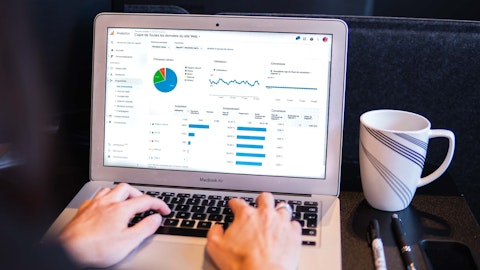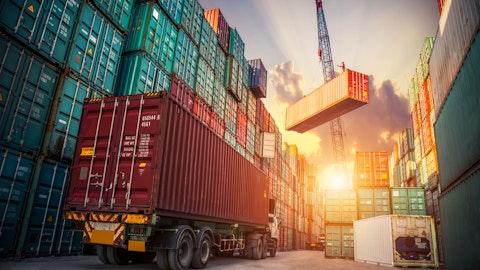Scott Group: Makes sense. Thank you guys. I appreciate the time.
Operator: Thank you. Your next question comes from the line of Jack Atkins with Stephens. Please go ahead.
Jack Atkins: Okay. Great. Good morning guys and thanks for taking my questions here. So, maybe if, I could just follow-up on that last line of questioning there for a moment. Fritz, I mean, as the business grows and matures and as you add terminals and service centers across the network gain density on the investments that you’ve been making. Could you maybe update us on how your thoughts around the incremental margin profile of the business should look? I mean I know right now, it’s obviously, it’s tougher in the short-term given how dynamic the market is, but how are you thinking about incremental margin. Incremental margins on your business over the longer-term now?
Fritz Holzgrefe: Yes. I think when you look back the last couple of years and we saw a more favorable environment as we grew adding facilities. I mean, you saw us getting so our incrementals is sort of 25% to 30% in there. I think as you go-forward, as we get more normal – normalized. We’ve been – brought all this new freight in our network and it stabilized, continue to open facilities. I think you’ll see us return our incremental margins to that level. Now, of course, if the – if most of that comes in the revenue line in the form of pushing our pricing to more market levels, than maybe we would push up that incremental margin profile. But as the company build scale over-time. I think that scale, automatically means that those incrementals are going to get better. And I feel really good about that. I think that’s what’s going to drive this the OR into the 70s frankly it’s, because our ability to execute on that.
Jack Atkins: Yes, absolutely right. And we’ve seen accelerating incrementals from some of your competitors as that happens. So that makes a lot of sense. I guess maybe for my follow-up question. Just kind of kind of going back to October for a moment. There was further disruption from another competitor due to a cyberattack. Did you guys see much of a – have you seen much of an impact from that as, I guess that would have been the first-half of October. And yes, I guess, how do you think about all things considered, the amount of latent capacity you have in the network as it stands today?
Doug Col: Yes, good morning, Jack. Yes, we definitely saw an impact for a few days there. I mean, normal seasonality for us September to October, is down about 2%. And we’re running better than that we’re down, call-it 1% now. So, we definitely saw some effect from that disruption there and it feels like they got it resolved. But there were a few days there, where it was, we saw it flow-through. So, in terms of incremental capacity – we’re probably Jack it’s going be pretty similar response that have had in other quarters. It depends on the location, but I think – we’re sort of 15% to 20% incremental capacity. Some of the pinch points. We had Salt Lake City, we opened a replacement facility in that market in this quarter that’s a huge opportunity for us. So that helps the capacity numbers. So it, I think we’re in that range, but what – we also know-how to flex, we have to. So, we can go beyond that if need be.
Jack Atkins: Okay. Thanks here, for your time guys.
Operator: Thank you. Your next question comes from the line of Ken Hoexter with Bank of America. Please go ahead.
Ken Hoexter: Great, good morning. Great detail on the cost leverage. Just a follow-up on that last question there. Fritz you got 15% to 20%, but you grew volumes 18% October. So it was 15% to 20% before or was it 20% to 25%, 30% before and now you’re at 15%, 20%. I just don’t understand, just with the phenomenal thoughts. And then just other data – on time performance and claims ratio. Can you give us an update on those?
Fritz Holzgrefe: Yes, so on the capacity sort of comment. I mean, one of the things that we know-how to leverage, we know-how to leverage the linehaul network well. And – judiciously have used purchase transportation in that we know-how to manage that well keep maintain service levels with that. So that’s kind of our flex capacity. We’ve learned on that. So, we’re pretty comfortable with it. With respect to the service levels, we measure service levels on a variety of different points, whether it’s – pickup completion on-time delivery, it’s claims and we’re tracking at or below – at or above where we were prior to not only this disruption. But if you go back to even the most disruptive times. So, we’re very pleased with where we are with that. That’s an important measurement for our customers and as you know we measure that every day.
Ken Hoexter: So, is there a number that you gave in terms of on-time performance in claims ratio?
Fritz Holzgrefe: Yes and the claims number is what 0.58% and on-time we measure it we have our internal measurements and we’re 98% on-time outside – up 98%, 99% out as we report customers and internally we measure it on our own metrics we’re well above our internal standards.
Ken Hoexter: Okay. Just – I guess, with such a strong volume gain, your thoughts on the sustainability of those volume gains we’ve heard some of the peers struggled. We saw one carrier give some back in October. Any thoughts on the movement back of some of these volumes or the sustainability, continue to grow in the face of other struggling?
Fritz Holzgrefe: Well. I think people that valued service and on-time and quality they’re going to gravitate to Saia. I think folks that maybe you’re looking for cheaper service lower-quality service, they’re going to move on and we’re okay with that. We’re not, we’re not in the game to see how much incremental volume can drive. We’re looking at creating value, not only for our customers. But for our shareholders. So it’s, I’m not necessarily worried about seeing how fast we can grow. We’re more worried about executing and making sure that we’re in a position where we can get paid-for very-high levels of service and consistency.
Ken Hoexter: Fritz, thank you. I appreciate the time. It’s just obviously, the concern here is – phenomenal growth and the concern on how you get that cost leverage, but it sounds like, just something that continues over-time as you kind of work-through the quick added costs and just get the benefit with the pricing over time. I appreciate that.
Fritz Holzgrefe: Yes. Absolutely.
Operator: Thank you. Your next question comes from the line of Allison Poliniak with Wells Fargo. Please go ahead.
Allison Poliniak: Hi, good morning. Just wanted to go back to your comment on the pinch points. I think you mentioned in terms of terminal investment, maybe some incremental acceleration into next year potentially. Is this influx of volumes sort of highlighting any potential holes to your point pinch points, that maybe we would see that in the first half of the year. Just any thoughts there?





